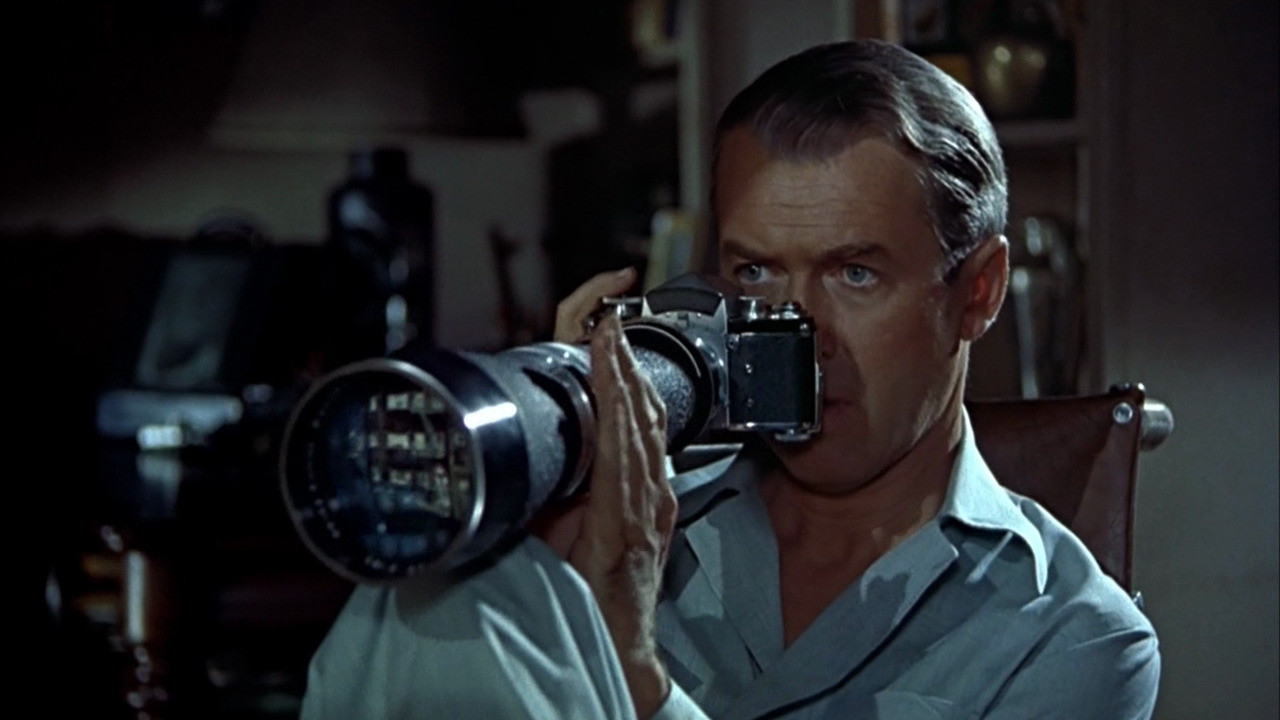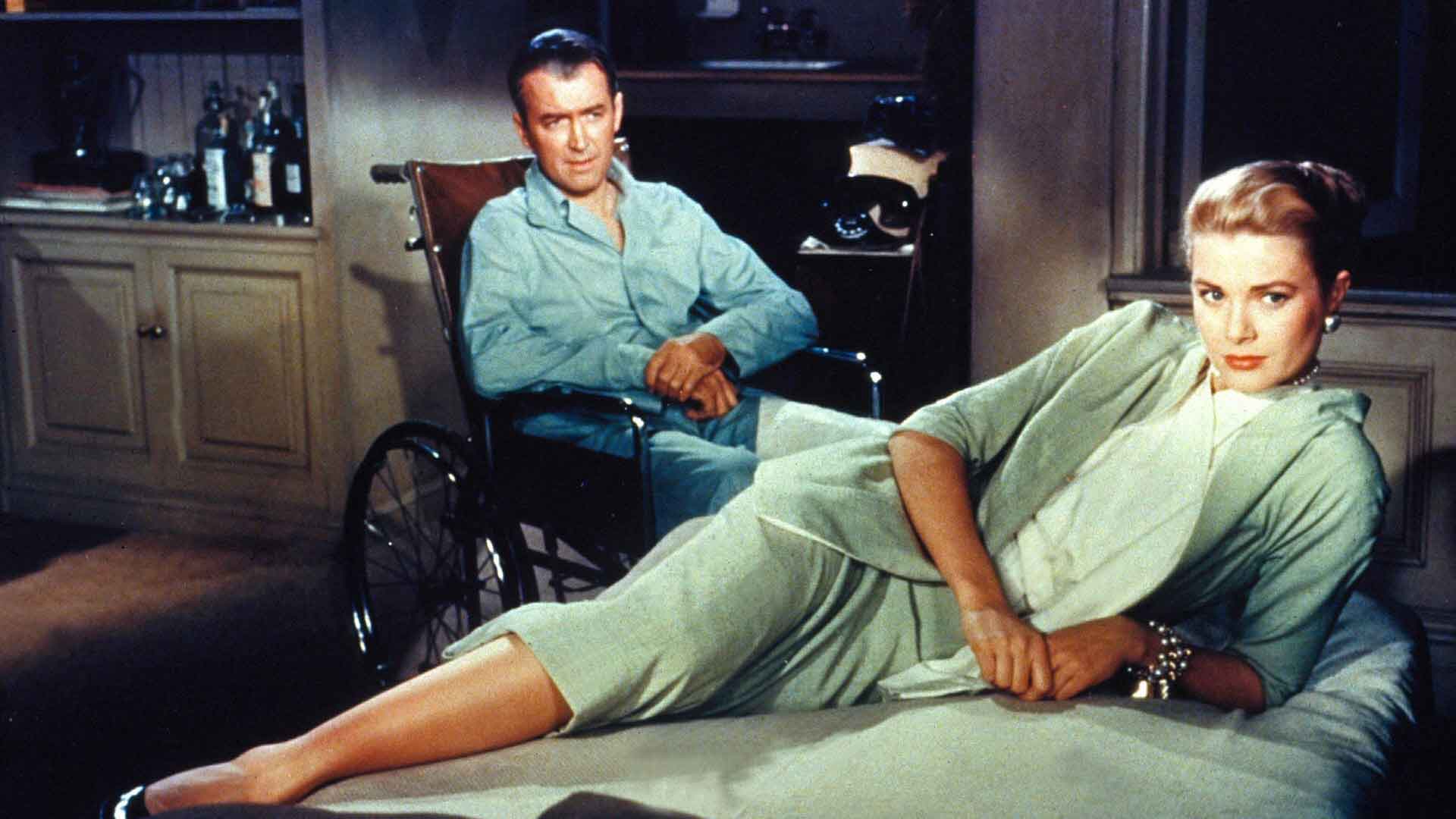The relationship between sound and film has been developed since 1929 into one of the most complex parts of filmmaking. Alfred Hitchcock, as one of the few directors to have worked in both silent and talking pictures, used sound in a variety of unique ways. In Rear Window he tells a murder mystery and a love story where both the suspense of the narrative and the point of view of the film rely on sound.
The music at the start of the film is a seemingly non-diagetic jazz beat. Looking around the courtyard reveals the setting and showing J.B. Jefferies asleep at the window reveals the main character. The jazz song ends and a radio advertisement begins. By looking into the musician’s apartment to the right the music is revealed to be playing over a radio. The musician tunes into a different station and a new song continues. The music that introduced the audience to the film turned out to be a diagetic part of the setting. This reversal of the first impression shows the audience that its point of view for this film is going to be very realistic. Throughout the film the point of view is completely limited to the apartment and the view from its window, and all the sounds occur in the reality of the story.
Another early scene is Jefferies talking to his editor over the phone. While he talks Jefferies watches and listens to his neighbors’ conflicts. Miss Torso is dancing around as she makes breakfast with her radio loud enough for Jefferies and the audience to listen from across the courtyard. The Sculptress who lives below Miss Torso angrily increases the volume on the radio she has hanging around her neck. Then the musician, attempting to write an original song, gets up from his piano to see what all the noise is. No one asks anyone else to turn down the music, each person sticks to himself or herself, but there is conflict being developed. When the owner of the strangled dog says to the courtyard, “You don’t know the meaning of the word neighbor. Neighbors like each other, speak to each other, care if anybody lives or dies,” she is putting into words what the audience already understands: these neighbors affect each other, but they don’t take notice of it.
The love story side of the film is alluded to during Jefferies’ first conversation with Stella, but Lisa Freemont doesn’t enter the picture until the following scene. At sunset the sounds through the window are traffic congestion, children playing, and a singer practicing scales. Behind the singer’s voice is the musician’s piano with an early version of “Lisa,” the song that will become the score for the film. Lisa approaches Jefferies and from her entrance to the slow-motion kiss the sounds fade away. Hitchcock is queuing the audience to its point of view and to the state of the film’s key relationship. Jefferies is not paying attention to the outside world when Lisa arrives, so the audience’s point of view follows his. The “Lisa” song becomes a reflection of their relationship. Jefferies is hesitant about marriage and the song is still unfinished.
LISAIt’s enchanting. It’s almost as if it were being written especially for us.JEFFERIESNo wonder he’s having so much trouble with it.
Music reflecting a character’s relationship is not limited in this film to Lisa and Jefferies. When Lisa goes into the kitchen to prepare their delivered dinner Jefferies looks out to the apartment of Miss Lonely-hearts. She is preparing her dinner for two for one and has a melancholy Sinatra song playing. Jefferies looks up to the Thorwald’s apartment and again the sound reflects their relationship. Sinatra fades and instead of music foghorns and police sirens back up their argument. The selection of music and sounds explains both Miss Lonely-hearts and the volatile situation in the apartment above without any dialogue.
Following Lisa’s departure Jefferies spends most of the night watching his neighbors. All is quiet when there is a car horn, a woman’s scream, and the smash of glass. Jefferies glances around, but can’t see anything. A series of fades jump through the night. It starts to rain, and the sound drowns out any other noise from the neighbors’ apartments. Jefferies sees Thorwald come and go more than once, but doesn’t see him leave with a woman early in the morning. Throughout this sequence the rain remains constant and unbiased. As a sound effect it doesn’t alter the point of view like the music or police sirens, and since this is the night that will be debated throughout the rest of the film it is best kept neutral. Without any leading sounds and by showing both what Jefferies sees and what he doesn’t the scene doesn’t betray the suspense of the film’s murder mystery plot and leaves the audience to decide on a meaning.
The next night Lisa is over, but Jefferies can’t keep his mind off of the mystery. The song in the background is their song, but the musician is playing it in a lower key with deeper tones and slower chords, as their relationship seems to be breaking apart. Lisa is ready to walk out when she sees Thorwald packing up the bedroom, which convinces her to stay and look deeper.
When Jefferies calls his police friend Tom Doyle to the apartment the next day he expects Doyle to believe him as easily as Lisa did, but Doyle is skeptical and happy to prove Jefferies wrong. Throughout their conversation Jefferies raises points and Doyle shoots them down. In the background a piece of circus music fades in. Like something that would come from a merry-go-round or an ice cream truck the music agrees with how Doyle sees the situation.
LISAThere’s that song again. Where does a man get inspiration to write a song like that?JEFFERIESWell, he gets it from the landlady once a month.
The “Lisa” song returns when Lisa comes over the next night. The musician is hosting a party and showing off what he has written. After Lisa arrives Tom Doyle returns. He is slightly more interested in the situation, but after a drink he gets a phone call that confirms Mrs. Thorwald is alive. He politely leaves. With Doyle gone the conversation quiets enough for the musician’s party to be heard again. The guests are all drunk and laughing but the musician is drunk and standing alone. Reflecting how disappointed Lisa and Jefferies are the sounds of the party mock them as they finally consider the ethical consequences of their actions.
The next night is the final confrontation. Lisa and Stella are with Jefferies when they realize something may be buried in the flowerbed. Jefferies writes a note and Lisa goes to deliver it. When Lisa is in the opposite building the musician is practicing with his band. They are playing an upbeat Jazz tune similar to the song at the beginning of the film. The similar styles of music, which bookend the film, queue the audience that this is the final scene. The music also runs contrary to the suspense of the scene. Jefferies has no way to contact Lisa as she is nearly caught by Thorwald when she leaves the note, but the music remains cheerful and quick throughout.
With a phone call Jefferies manages to get Thorwald out of his apartment. Lisa and Stella head into the courtyard to dig up the flowerbed. When they find nothing Lisa heads into Thorwald's apartment. At this moment the two sides of the film, the love story and the murder mystery, converge. Lisa is in the apartment waiting for a phone call to warn her if Thorwald is coming. The musician says to his band “Ok, guys, let’s try this once from the beginning,” just as Stella, Jefferies and the audience see Miss Lonely-hearts pick up the pills and water. Jefferies has to call the police for Miss Lonely-hearts, so he can’t call Lisa to warn her. The song that the band is now playing in its entirety is “Lisa.” At this moment Jefferies does love Lisa, and so the full and complete song reflects that. The song had previously only played for the love story, but now Lisa is in trouble and the song is playing. The love story is pushed into the murder mystery and all the elements of the film converge with them.
The police arrive for Miss Lonely-hearts, but hear Lisa scream for help. They get to the apartment in time to save and arrest her. Lisa, knowing Jefferies is watching, shows him Mrs. Thorwald’s wedding ring, but Mr. Thorwald sees. He looks up. Throughout the film the audience has been rooted in a realistic point of view by not being shown any image or sound that someone in the apartment wouldn’t. The moment when Thorwald looks directly at the audience is shocking because of this conditioning. It is as if Thorwald is looking at them and not just Jefferies.
The buildup with Lisa in the apartment seemed like the climax, but the police, Lisa and Stella all leave the scene. Jefferies is alone and suddenly he can’t see Thorwald, and he didn’t see him leave. Again the conditioning to see everything from Jefferies’ point of view creates suspense. After the commotion of Lisa’s arrest the musicians stopped playing. The situation Jefferies is in gets no background music to distract from the pounding of Thorwald’s footsteps up the stairs and down the hall. Thorwald enters the apartment and Jefferies stops him with a flash bulb. The crack of the bulb, Jefferies frantically replacing it and Thorwald stepping closer increase tension as one sound follows another in a rhythm.
The rhythm of the flashbulb scene contrasts wildly with the final fight. Thorwald grabs Jefferies and pulls him out of his chair. Fast cuts to people outside the apartment break the point of view that has been developed. Fast shots of Thorwald pushing Jefferies toward the window and people running to watch are inter-cut with close-ups and wide shots. Throughout this tension there is no music, and almost no sound except Jefferies’ panicking breath and Thorwald’s grunts. The point of view is brought back to Jefferies and he falls to the courtyard below. A woman screams and then the fast cutting ends. Jefferies is alive and looking into Lisa’s eyes. The final conflict of the murder mystery ties up with the final resolution of the love story. The scene in most films would have a heart-pounding soundtrack, but keeping to his completely diagetic score Hitchcock created a nearly silent final confrontation.
The film’s resolution paints a quick picture of the future Lisa and Jefferies will have together. He sleeps in two casts while she reads a travel book before switching to a fashion magazine. In the background is the finished record of “Lisa.” The mystery is solved, their relationship has progressed, and the song has been written. The story is done and Hitchcock, as the storyteller, makes a quick exit.
TOM DOYLE(Talking about the buried evidence)Wanna look?STELLANo thanks; I don’t want any part of it.






